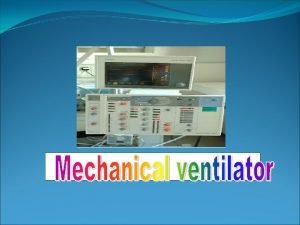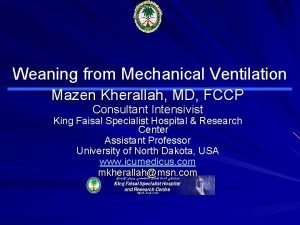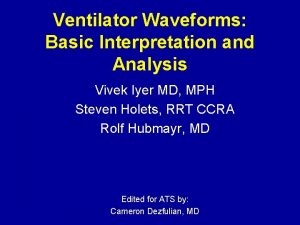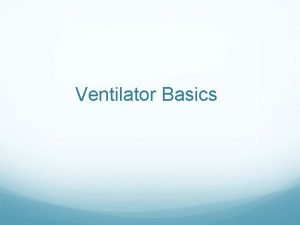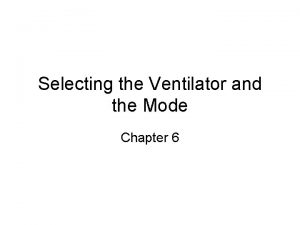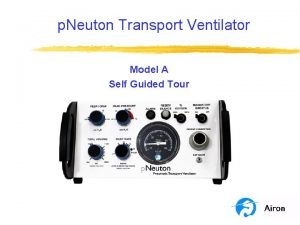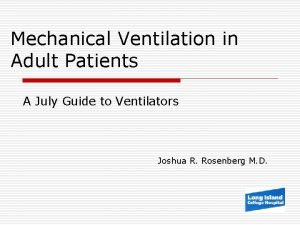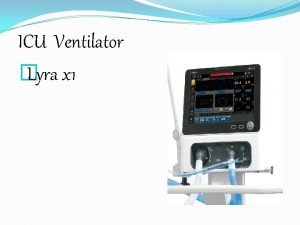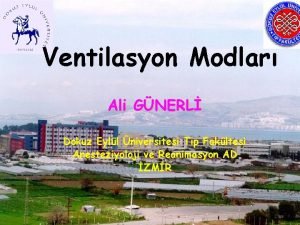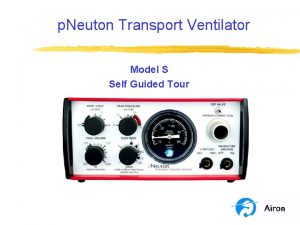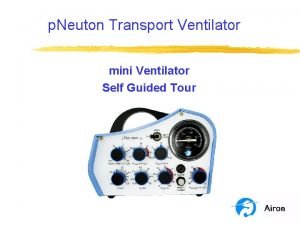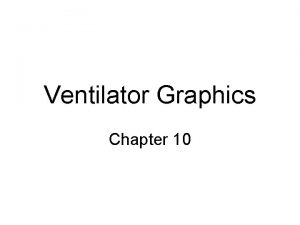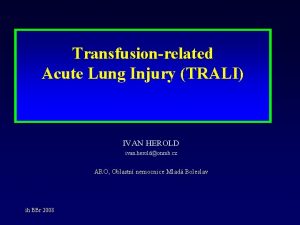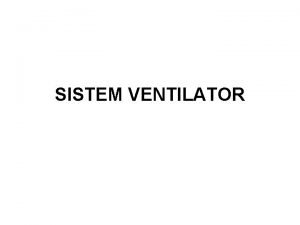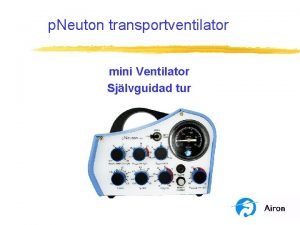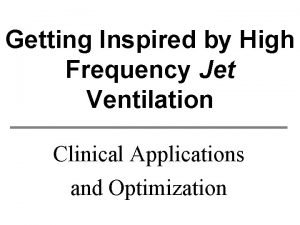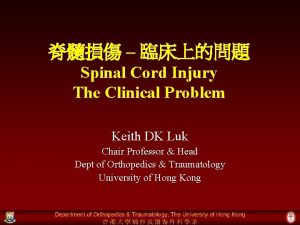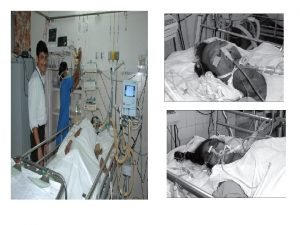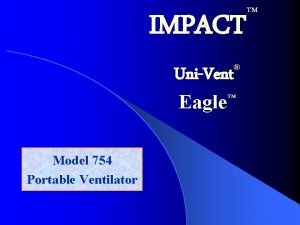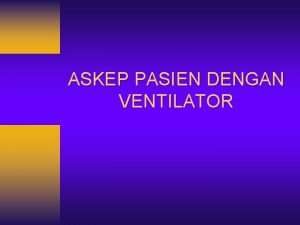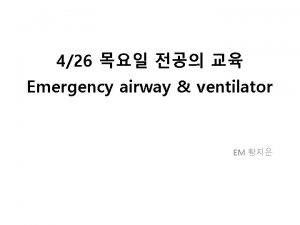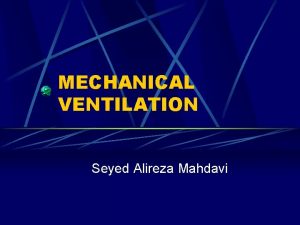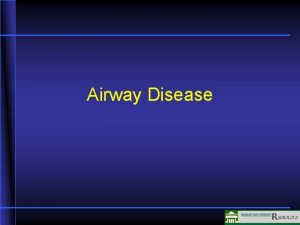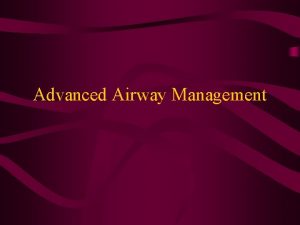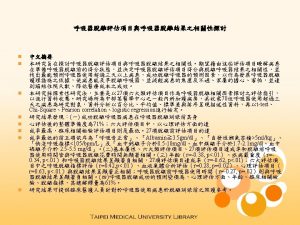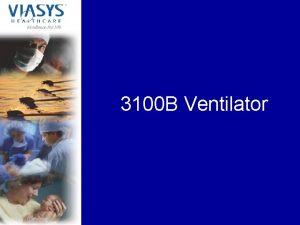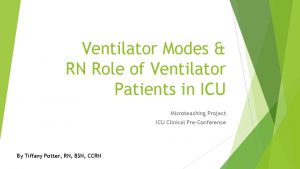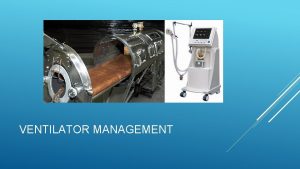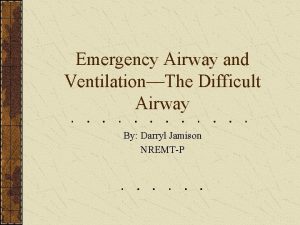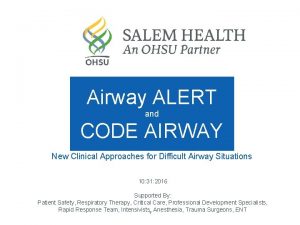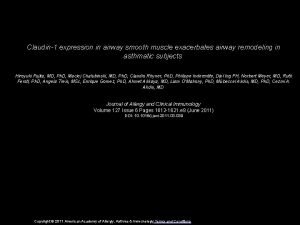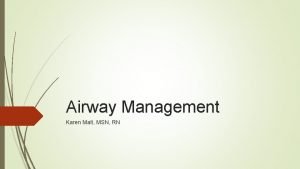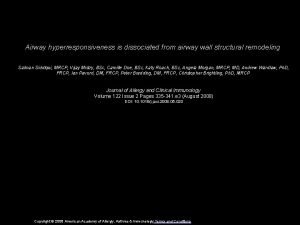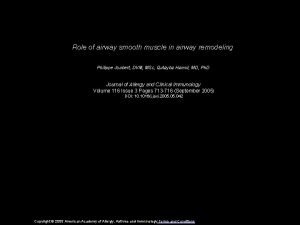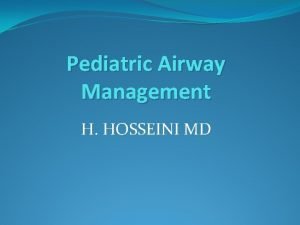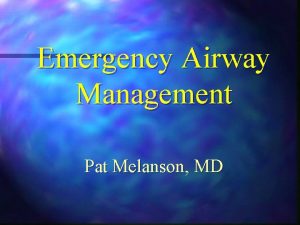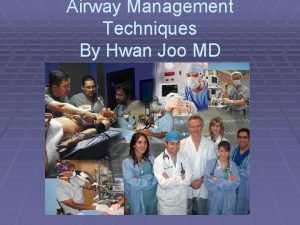Airway and Mechanical Ventilator Skills and Knowledge Contents























- Slides: 23

Airway and Mechanical Ventilator Skills and Knowledge 部立雙和醫院胸腔內科 內科加護病房 陳資濤

Contents l l l Evaluate the patients who needs intubation Introduction of mechanical ventilation Ventilator settings l l Elements of ventilator settings Introduction of non-invasive ventilation (NIV)


Prediction of Difficult Intubation l l l L = Look (觀察) E = Evaluate the mouth opening and airway position (評估開口程度與氣道位置) M = Mallampati score O = Obstruction (排除阻塞) N = Neck mobility (評估頸部活動度)

The 3 -3 -2 Rule l l l 3: The mouth opening ≧ 3 fingers 3: Tip of the chin to the hyoid bone ≧ 3 fingers 2: Hyoid bone to the top of the thyroid cartilage ≧ 2 fingers

Mallampati Score

傳統/高階呼吸器 Bennett MA-1 Dräger Evita XL

Indications for Mechanical Ventilation l l Respiratory arrest ARDS Acute respiratory distress with accessory muscle breathing Hypoxemia or hypercapnia with respiratory acidosis l l l p. H <7. 3, Pa. O 2 < 60 mm. Hg or Pa. CO 2 >45 mm. Hg Severe chest contussion General anesthesia

Elements of ventilator settings l Control How the ventilator knows how much flow to deliver. l Volume Controlled (volume limited, volume targeted) and Pressure Variable l Pressure Controlled (pressure limited, pressure targeted) and Volume Variable l Dual Controlled (volume targeted (guaranteed) pressure limited)

Elements of ventilator settings l Cycling How the ventilator switches from inspiration to expiration. l Time cycled – such as in pressure controlled ventilation l Flow cycled – such as in pressure support l Volume cycled – the ventilator cycles to expiration once a set tidal volume has been delivered: this occurs in volume controlled ventilation. If an inspiratory pause is added, then the breath is both volume and time cycled

Elements of ventilator settings l Triggering What causes the ventilator to inspiration. l Time – the ventilator cycles at a set frequency as determined by the controlled rate. l Pressure – the ventilator senses the patient's inspiratory effort by way of a decrease in the baseline pressure. l Flow – modern ventilators deliver a constant flow around the circuit throughout the respiratory cycle (flowby). A deflection in this flow by patient inspiration, is monitored by the ventilator and it delivers a breath. This mechanism requires less work by the patient than pressure triggering.

Elements of ventilator settings l Breath pattern What causes the ventilator to cycle from inspiration. l Mandatory (controlled) - which is determined by the respiratory rate. l Assisted - as in assist control, synchronized intermittent mandatory ventilation, pressure support l Spontaneous - no additional assistance in inspiration, as in CPAP

Elements of ventilator settings l Flow pattern l l Sinusoidal - this is the flow pattern seen in spontaneous breathing and CPAP Decelerating - most intensivists and respiratory therapists use this pattern in volume targeted ventilation also, as it results in a lower peak airway pressure than constant and accelerating flow, and better distribution characteristics Constant - flow continues at a constant rate until the set tidal volume is delivered Accelerating - flow increases progressively as the breath is delivered. This should not be used in clinical practice.

Elements of ventilator settings l Mode l l CMV - Conventional controlled ventilation, without allowances for spontaneous breathing. Many anesthesia ventilators operate in this way. Assist-Control - Where assisted breaths are facsimiles of controlled breaths. Intermittent Mandatory Ventilation - Which mixes controlled breaths and spontaneous breaths. Breaths may also be synchronized to prevent "stacking". Pressure Support - Where the patient has control over all aspects of his/her breath except the pressure limit.

CMV

A/CV

SIMV

PSV (pressure support ventilation) Spontaneous inspiratory efforts trigger the ventilator to provide a variable flow of gas in order to attain a preset airway pressure. Can be used in adjunct with SIMV.

Main determinants l Oxygen in l l l F IO 2 mean alveolar pressure PEEP l Re-open alveoli and shunt l Carbon dioxide out l ventilation l RR l tidal volume


Evidences for Use of NPPV

Contraindications to NIV

Thank you very much for attention!
 Larangoscopy
Larangoscopy Mode of ventilation
Mode of ventilation Actual mechanical advantage vs ideal mechanical advantage
Actual mechanical advantage vs ideal mechanical advantage Knowledge creation and knowledge architecture
Knowledge creation and knowledge architecture Minute ventilation
Minute ventilation Pressure volume loop ventilator
Pressure volume loop ventilator Normal peak pressure
Normal peak pressure Mode of ventilation
Mode of ventilation P neuton ventilator
P neuton ventilator Peak pressure ventilator
Peak pressure ventilator Lyra ventilator
Lyra ventilator Mekanik ventilatör modları
Mekanik ventilatör modları P neuton ventilator
P neuton ventilator P neuton ventilator
P neuton ventilator Rapid interpretation of ventilator waveforms
Rapid interpretation of ventilator waveforms Plicni ventilator manufacturer
Plicni ventilator manufacturer Cara kerja kopling fluida
Cara kerja kopling fluida Programml
Programml Mean airway pressure formula
Mean airway pressure formula Servo pressure on hfjv
Servo pressure on hfjv Spinal cord injury protocol
Spinal cord injury protocol Define ventilation
Define ventilation Impact 754 ventilator
Impact 754 ventilator Setting ventilator
Setting ventilator

